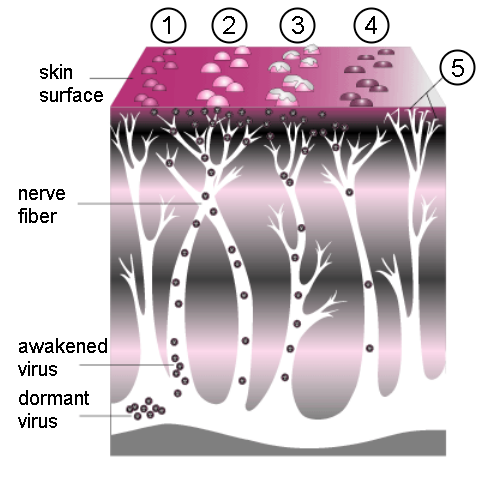 What is herpes zoster?
What is herpes zoster?
Herpes zoster (HZ), also known as shingles, is a skin rash caused by reactivation of varicella-zoster virus (VZV). Varicella-zoster virus is the same virus that causes “chicken pox”. After infection with this virus, the virus is never cleared from the body. It becomes latent, hiding in the sensory nerves. In adulthood, VZV virus can become reactivated causing herpes zoster. Typically the rash is in the area of one nerve, called a dermatome, and demonstrates typical patterns on the skin.
What are the symptoms of herpes zoster?
There is usually a prodrome along one or more dermatomes lasting several days before the rash erupts. This is usually painful, and less commonly itchy or tingly. Systemic symptoms are sometimes present, including headache, muscle aches, light sensitivity, and sometimes fever.
After the prodrome phase, the rash erupts. This typically begins as redness in the involved area, followed by grouped herpetiform blisters. Lymph nodes may be swollen in the affected region. Since lesions usually affect a single dermatome, the rash stops abruptly at the body’s mid-line. The vesicles are initially clear, but then crust as they heal. Pain is usually present. The vesicles resolve over approximately two weeks, while residual redness can last for several weeks.
In some cases, post-herpetic neuralgia can develop. This is pain more than 30 days after the acute infection is over. Pain is often sever, and can last for months or even years.
Who gets herpes zoster (shingles)?
Herpes zoster can effect people at any age, but it is more common as people age, as the immune system weakens. It is estimated that in people over 85, approximately 50% will develop the rash of shingles.
How is shingles diagnoses?
Shingles is often a clinical diagnosis. The typical dermatomal pattern of the rash and the distinctive painful symptoms are usually sufficient to make a diagnosis. When necessary a viral culture, direct fluorescent antigen test, PCR, or a biopsy are necessary to confirm the diagnosis.
How is herpes zoster treated?
Herpes zoster is treated with antiviral medications, typically Valtrex (valacyclovir). Medication should be started as early as possible in the course of the infection. NSAIDs, such as ibuprofen, can be used for pain. Topical calamine lotion or Burrow’s solution can be used as well. Oral steroids are sometimes used in the belief that it can reduce the risk of post-herpetic neuralgia. This has not been firmly established, and is still controversial. If there is bacterial superinfeciton it can be treated with topical antibiotics.
What is post-herpetic neuralgia?
Herpes zoster, even after it resolves, can sometimes result in persistent pain in the affected area. This is called post-herpetic neuralgia. Treating herpes zoster as early as possible may prevent post-herpetic neuralgia. When it occurs, post-herpetic neuralgia can be difficult to treat. Medications such as gabapentin and tricyclic antidepressants are often used, along with narcotic and non-narcotic pain medications..
Can herpes zoster be prevented?
There are two vaccines available to prevent herpes zoster virus. Zostavax is a live vaccine, and Shingrix is a recombinant vaccine. They are recommended for older adults at risk for developing shingles.
Is herpes zoster contagious?
During the acute phase when active lesions are present, herpes zoster is contagious. Infected patients should avoid contact with people that might be at risk, including the elderly, immunocompromised people, pregnant women, and anyone with no history of chickenpox infection or vaccination, especially infants and babies.
See e-medicine for further information on shingles.

